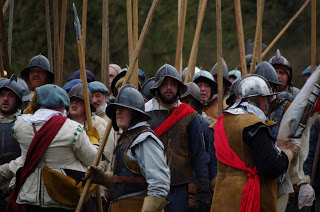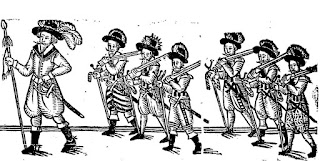Newark
Newark played an important role in the Civil War and has a number of places of interest for the Civil War enthusiast.
First off is the National Civil War Centre, housed in the old Newark museum the buildings have been tastefully renovated. The main gallery is devoted to the Civil Wars, mostly interpretative panels and interactive stuff (and dressing up) for the kids. They have recently acquired 25 pieces of armour which they hope to display in the coming years. This should pad out the collection nicely.
Postcodes for SatNavs
Sconce (Devon Park) NG24 4AU
National Civil War Centre NG24 1JY (parking for the centre is a few hundred metres further down the one way road on the left hand side, just after the junction with the two way road NG24 1JR)
First off is the National Civil War Centre, housed in the old Newark museum the buildings have been tastefully renovated. The main gallery is devoted to the Civil Wars, mostly interpretative panels and interactive stuff (and dressing up) for the kids. They have recently acquired 25 pieces of armour which they hope to display in the coming years. This should pad out the collection nicely.
The museum has a slowly revolving exhibition upstairs, the current exhibition is 'The World Turned Upside Down'; previous exhibitions have looked at C17th battlefield medicine, and (at the time when I first wrote this entry) 'Cutting Edge' - which had a number of Sir Thomas Fairfax's military items (complimenting his wheelchair which takes pride of place in the entrance). There are also a number of other military items on display. The following pictures, are from that exhibition.
If you get the chance, and have a willing assistant, might I suggest that you try the grey waistcoat on (in the corner of the new exhibition). 3lb bags of sand are added to the pockets placed all over the waistcoat. Ten bags equals a buff coat, back and breastplate, and helmet. Twenty three a full cuirassier suit. You'll very quickly realise why the cuirassier was doomed to extinction on the battlefield.
The Centre developed an app guide which provided augmented reality to the Newark Civil War trail; alas the app is now defunct, which is unfortunate as the imagery on the information boards, and the two large displays in the museum, now make little sense. These panels feature QR codes which accessed features on a now defunct smartphone app. Each location also featured an eye witness account - stories from real people who witnessed the events in Newark. Each information panel has a photographic representation of the person whose story was told in the app.
The information board at the Castle, shares the story of John Americanus, a man of African descent. Unfortunately there's no mention of these eyewitness testimonies on the information panel themselves. As a result, the representation of John stirs up controversy every so often, with claims of 'woke blackwashing'. Without this context, it is perfectly reasonable to ask why is there an image of a man of African descent seemingly illustrating the Civil War. John was a stablehand, ended up fighting for the defence of Newark, and there is a record of him scaring a Scot to death in 1645 (the Scot had never seen a black man before).
The trail itself is short enough for small people not to get too bored, plus you can play spot the cannonball hole in the spire of St Mary's Church opposite the NCWC.
As you follow the trail from the NCWC to St Mary's, take a detour to the garden on your right. In the centre of the gardens you will find a memorial to many of Newark's great and good who died during the siege, and who were originally interred inside the church.
St Mary's was garrisoned during the siege, but other than the supposed cannon ball hole, the garrison left little evidence that they were there.
Worth a visit though as there are three interesting memorials: the first to Thomas Atkinson, who petitioned the Parliamentary Commissioners for damage sustained during the siege to his property. He claimed that he had kept the Olde White Hart (in the market place, now empty) in good repair until
"Newark was besieged by the Parliaments forces and through a bumball or granado shott which came from the besiegers a great part of the said howse was blowne upp and some were there slaine and others mortally wounded".
The second to Robert Ramsey, servant to his majesty (Charles I).
The third is to John Johnson, twice mayor of Newark.
There is an interesting story attached to the drive and the mayor of Newark at the time, one Hercules Clay. Hercules had a dream on three consecutive nights that his house would be destroyed by cannon fire, so he moved his family out. Not long after his house was burnt to the ground as a consequence of artillery fire. Grateful for his escape, Clay left an endowment for an annual service of thanksgiving to be held at St Mary Magdalene Church, which continues to this day. Hercules Clay Day is celebrated in the town, and there's often some re-enactors firing their muskets and drilling. (Closest Sunday to March 11th, occasionally moves by a week if it clashes with Mothering Sunday.)
 |
| The Mill Gate board (easily missed) is located in a small park directly opposite an Aesthetics and Beauty parlour. |
Not on the trail are a number of interesting buildings.
 |
| The Prince Rupert public house |
 |
| The Governor's House, where Rupert lodged, during its life as a branch of Greggs; it is now a cafe |
Tucked away down Eggleston's Yard (running by the side of the Governor's House) is a slightly more interesting plaque.
 |
| Queen Henrietta Maria's lodgings are now a bed shop and gallery |
The Queen's Sconce is pretty well preserved and gives a good idea of defensive earthworks. The park it is located in often plays host to the Sealed Knot. If you are travelling any distance I'd recommend timing your visit with one of these events. Or if you are a wargamer, one of the Partizan shows, or Hammerhead.
Newark's defences where very well documented and there are still many visible remains, most notably the Queen's Sconce. There are two more intact sconces in Newark, and the remains of several other earthworks. I've tried to 'plot' those onto my Newark map. For a fuller explanation, and important notes and warnings see here.
Sconce (Devon Park) NG24 4AU
National Civil War Centre NG24 1JY (parking for the centre is a few hundred metres further down the one way road on the left hand side, just after the junction with the two way road NG24 1JR)
If you enjoyed reading this, or any of the other posts, please consider supporting the blog.
Thanks.


























Comments
Post a Comment